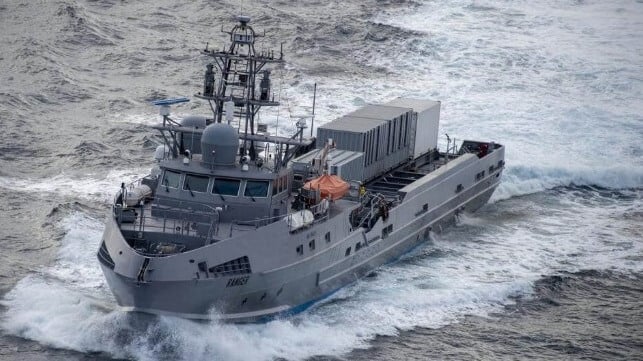U.S. Navy Wants to Buy Combat-Ready USVs With Containerized Payloads

U.S. Naval Sea Systems Command has released an RFI for another set of new unmanned surface vessels, which might be in line to fulfill the unkept promises of the Littoral Combat Ship.
Nearly 30 years after the conception of the Streetfighter, the Navy has returned to a strikingly similar idea: the service's unmanned-vessel office wants to buy three bare-bones platforms that are small, fast, cost-efficient, lightly-manned, and ready for swappable weapons systems - much like a conceptual LCS. But with low-risk unmanned operation and easy-change containerized payloads, this reboot of the concept just might succeed where the manned LCS did not.
The newly-announced Modular Attack Surface Craft (MASC) program is the latest in a series of trial-scale USV initiatives and draws upon predecessor designs, but under a different name and with bigger ambitions. The vessel specification favors a high speed crewboat design, with an unobstructed working deck capable of hosting 20- or 40-foot boxes. This is the same general arrangement as the much-discussed Ghost Fleet Overlord USVs, Ranger and Nomad, which are offshore crewboat conversions.
MASC appears to expand upon and subsume another new program name, the "Future USV," a medium-sized hull with capacity for two forty-foot boxes on deck. Requirements for Future USV were announced earlier this year, and include open ocean capability, a 25-plus knot top speed, long endurance, autonomy, and "non-exquisite" design.
The same vessel specification appears in the just-released RFI as the base case MASC design, with a minimum range of 2,500 nautical miles - enough to reach Guam from Midway.
The second MASC vessel concept is a "high capacity" variant with room for four 40-foot containers. The third is a reduced-size version capable of carrying a single 20-foot box.
For a sense of what might fit into a containerized payload, one 40-foot Mark 70 modular vertical launch system can carry four full-length missiles, including the SM-series and the Tomahawk. This would give each "high capacity" MASC a total of 16 VLS cells, without the expense (or the lives at risk) of a 32-VLS-cell frigate. The on-deck Mark 70 concept has been live-fire tested aboard the Ghost Fleet Overlord USVs before.
The Navy is also seeking a modular containerized launcher for the Mark 48 heavyweight torpedo, which could give MASC a potent anti-ship capability.
While its previous USV programs have been trial-sized in nature, the Navy now has more resources and experience to pursue unmanned vessels at scale. The One Big Beautiful Bill Act allocated $1.5 billion for small USVs, $2.1 billion for medium USVs, $188 million for unmanned vessel R&D, and $174 million for an autonomy test center - on top of the Navy's FY2026 defense bill appropriation.
The opinions expressed herein are the author's and not necessarily those of The Maritime Executive.
